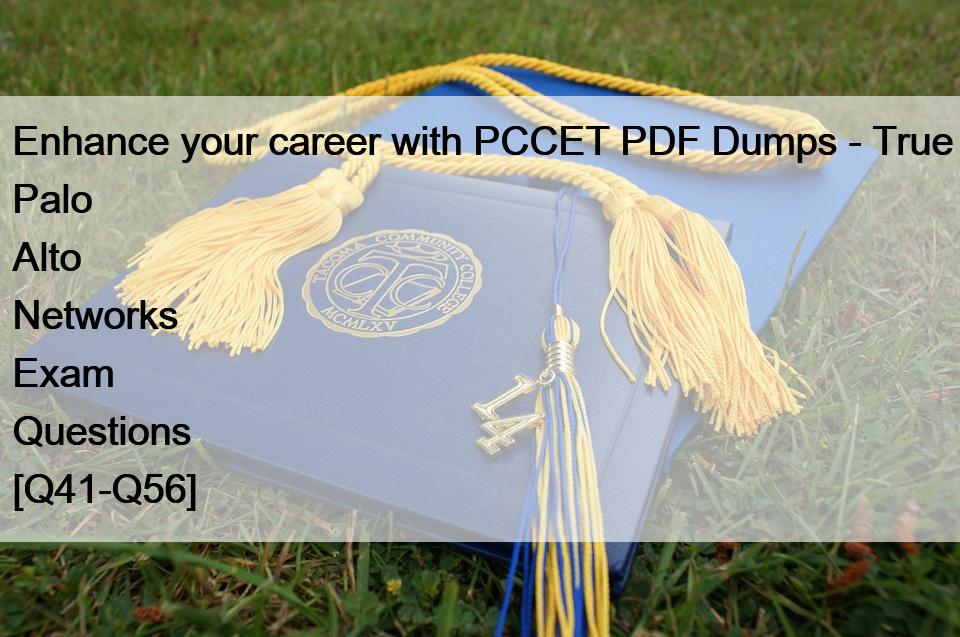Enhance your career with PCCET PDF Dumps – True Palo Alto Networks Exam Questions
New (2022) Download free PCCET PDF for Palo Alto Networks Practice Tests
Palo Alto PCCET Exam Topics:
| Section | Weight | Objectives |
|---|---|---|
| The Connected Globe | 25% | – Define the differences between hubs, switches, and routers
– Classify routed and routing protocols
– Summarize area networks and topologies
– Explain the purpose of the Domain Name System (DNS)
– Identify categories of Internet of Things (IoT)
– Illustrate the structure of an IPV4/IPV6 address
– Describe the purpose of IPV4 subnetting.
– Illustrate the OSI and TCP/IP models
– Explain the data encapsulation process
– Classify the various types of network firewalls
– Compare intrusion detection and intrusion prevention systems
– Define virtual private networks
– Explain data loss prevention
– Describe unified threat management
– Define endpoint security basics
– Compare signature and container-based malware protection
– Recognize types of mobile device management
– Explain the purpose of identity and access management
– Describe configuration management
– Identify next-generation firewall features and capabilities
– Compare the NGFW four core subscription services
– Define the purpose of network security management (Panorama)
|
| Cloud Technologies | 30% | – Define the NIST cloud service and deployment models
– Recognize and list cloud security challenges
– Define the purpose of virtualization in cloud computing
– Explain the purpose of containers in application deployment
– Discuss the purpose of serverless computing
– Compare the differences between DevOps and DevSecOps
– Explain governance and compliance related to deployment of SaaS applications
– Illustrate traditional data security solution weaknesses
– Compare east-west and north-south traffic protection
– Recognize the four phases of hybrid data center security
– List the four pillars of cloud application security (Prisma Cloud)
– Illustrate the Prisma Access SASE architecture
– Compare sanctioned, tolerated and unsanctioned SaaS applications
|
| Fundamentals of Cybersecurity | 15% | – Identify Web 2.0/3.0 applications and services
– Recognize applications used to circumvent port-based firewalls
– Summarize cloud computing challenges and best practices
– Identify SaaS application risks
– Recognize cybersecurity laws and regulations
– List recent high-profile cyberattack examples
– Discover attacker profiles and motivations.
– Describe the modern cyberattack life-cycle
– Classify malware types
– List the differences between vulnerabilities and exploits
– Categorize spamming and phishing attacks
– Social Engineering
– Cybersecurity Attacks
– Define the characteristics of advanced persistent threats
– Recognize common Wi-Fi attacks
– Define perimeter-based network security
– Explain Zero Trust design principles and architecture configuration
– Define the capabilities of an effective Security Operating Platform
– Recognize Palo Alto Networks Strata, Prisma, and Cortex Technologies
|
| Elements of Security Operations | 30% | – List the six essential elements of effective security operations
– Describe the purpose of security information and event management (SIEM) and SOAR
– Describe the analysis tools used to detect evidence of a security compromise
– Describe features of Cortex XDR endpoint protection technology
– Describe how Cortex XSOAR improves SOC efficiency and how Cortex Data Lake improves SOC visibility
– Explain how AutoFocus gains threat intelligence for security analysis and response.
|
Palo Alto PCCET Exam Certification Details:
| Exam Name | Cybersecurity Entry-level Technician |
| Passing Score | Variable (70-80 / 100 Approx.) |
| Exam Code | PCCET |
| Duration | 90 minutes |
| Exam Price | $110 USD |
| Exam Registration | PEARSON VUE |
100% Free PCCET Files For passing the exam Quickly: https://www.validbraindumps.com/PCCET-exam-prep.html






